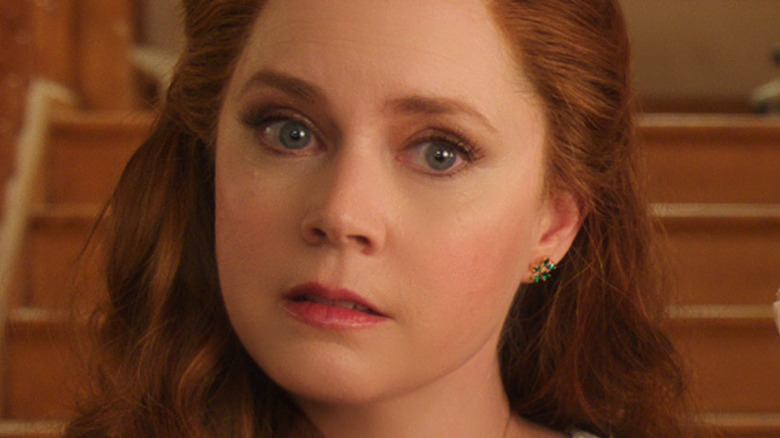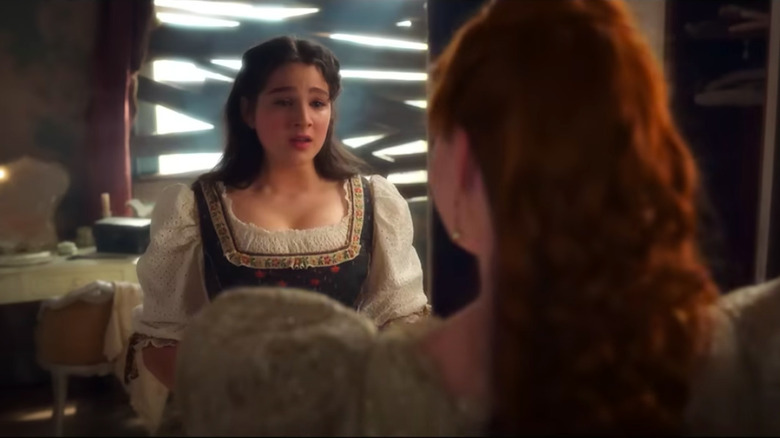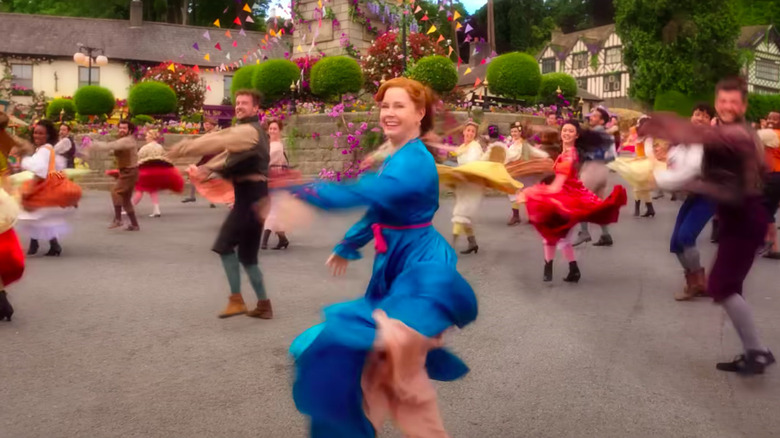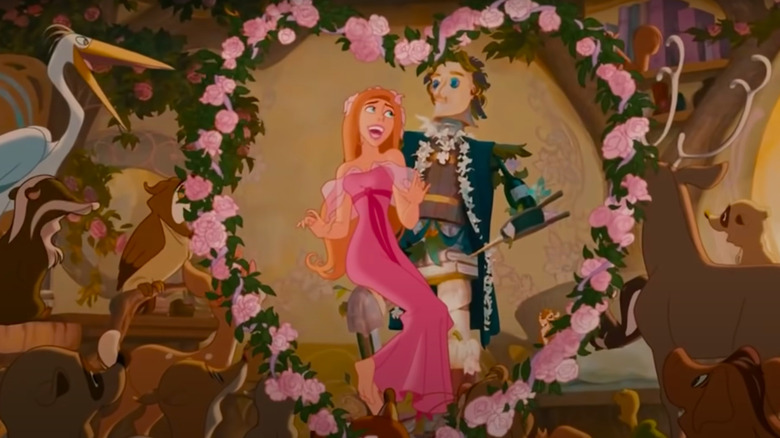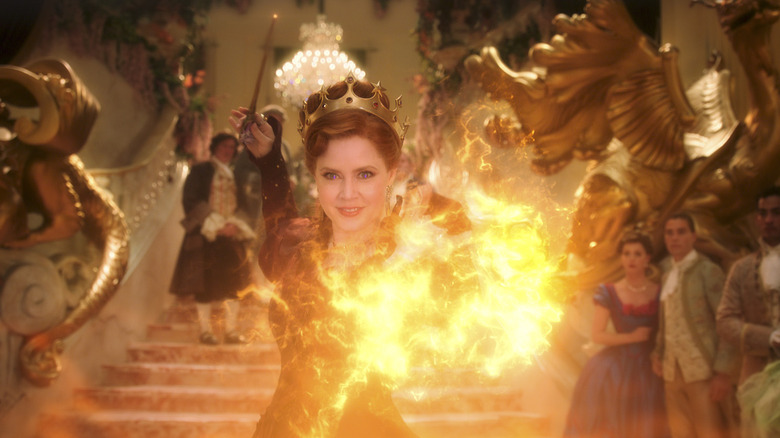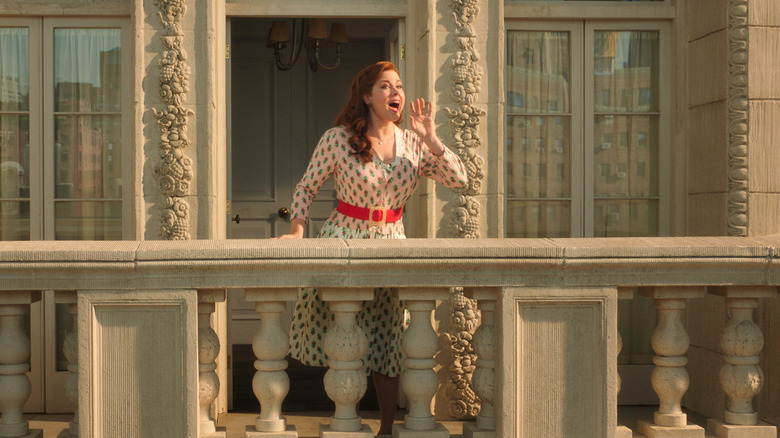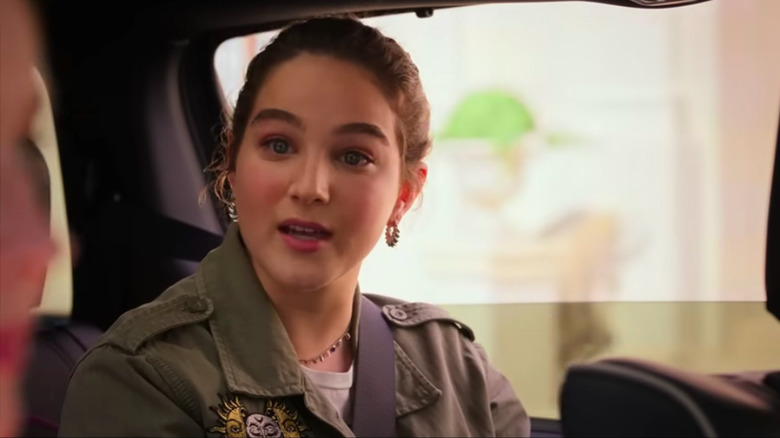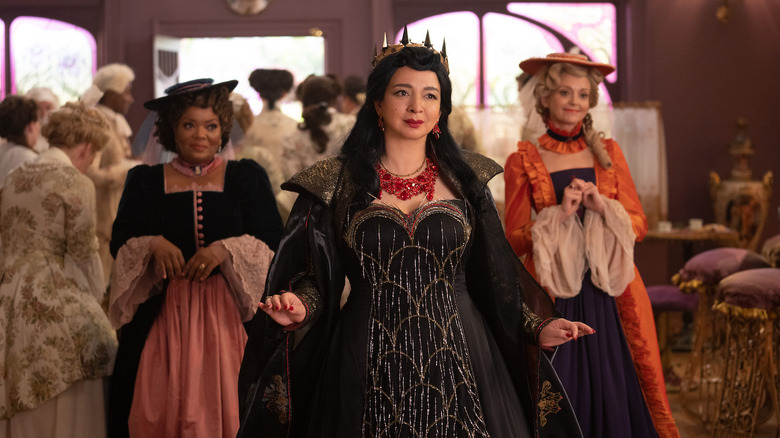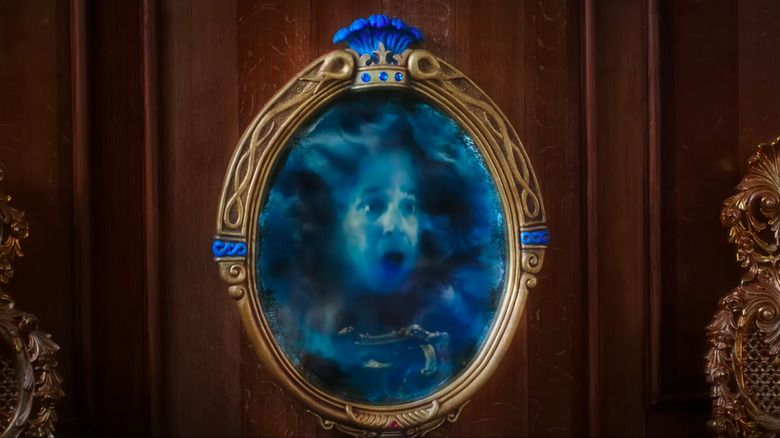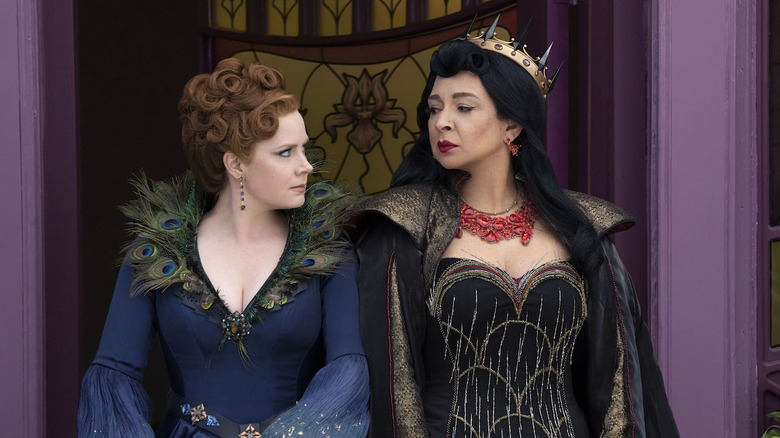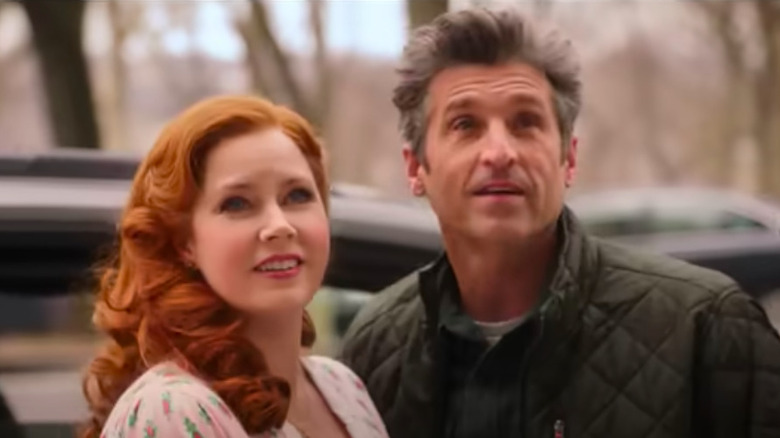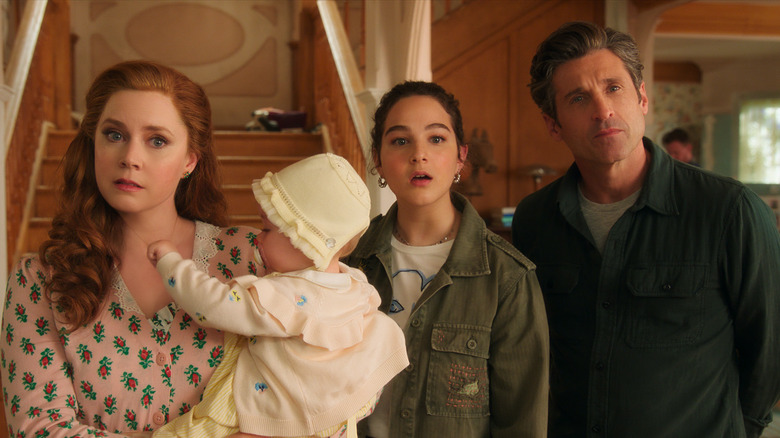Small Details You Missed In Disenchanted
"Disenchanted" continues the story of the 2007 Disney hit "Enchanted," in which fairy-tale character Gisele (Amy Adams) from the animated land of Andalasia is pushed through a portal that takes her to the harsh environment of New York. Gisele's relentless optimism and belief in love help her weather the strange new world and even enable her to find her true love, Robert (Patrick Dempsey), a lawyer with a young daughter named Morgan (Rachel Covey). All three characters return in the new film, and while Gisele has now lived in New York for years, she still maintains her connection to Andalasia, especially through visits from her former flame, King Edward (James Marsden), and his wife, Queen Nancy (Idina Menzel).
When "Disenchanted" begins, Gisele is worn out by new baby Sofia and missing the easy happily-ever-afters that are a natural part of life in Andalasia. In a bid to recapture the magic of her earliest days with Robert and Morgan, Gisele and her family move to the small suburban town of Monroeville. But when Monroeville doesn't become the answer to her problems that she expected, Gisele uses a wishing wand to change the town into a fairy tale, a transformation that leads to disaster when it causes Gisele to evolve into an archetypal wicked stepmother. This version of Gisele can't stand the now-teenaged Morgan (Gabriella Baldaccino) and wants to take control of the town now known as Monrolasia from Malvina (Maya Rudolph), its current queen. As with the first film, there are tons of fairy tale references and small details that you may have missed, so let's take a look at some of the most notable ones in "Disenchanted."
Contains spoilers for "Disenchanted."
There are tons of classic Disney movie nods
Given how popular Disney's animated classics remain even decades after they were released, fans had a blast looking for all the references to them in "Enchanted." That remains the case in "Disenchanted," which packs in so many nods to classic Disney animated movies that it's almost impossible to notice them all.
For example, when Gisele's fairy-tale world becomes a reality, Morgan becomes a damsel in the vein of Snow White and Cinderella. But as Gisele becomes more like the wicked stepmother from "Cinderella," Morgan is more exclusively like the title character — her dress for the Monralasia celebration is even ripped to shreds and then magically transformed into a fancy blue ball gown like Cinderella's. Similarly, Malvina becomes more or less an avatar for the Evil Queen from "Snow White and the Seven Dwarfs," complete with magic mirror, and Gisele's chipmunk best friend Pip (Griffin Newman) transforms into an evil cat just like Lucifer, the feline from "Cinderella."
In addition, the dancing broom that cleans the house after Gisele makes her wish is a "Fantasia" reference, while the vines that grow around the venue holding the town festival and the three fairies taking care of Sofia are both lifted from "Sleeping Beauty." At one point, Malvina's henchman are wearing dresses that replicate those of Cinderella's wicked stepsisters. Finally, during Gisele and Malvina's duet on "Badder," there are several fun things to notice in Malvina's cupboards, including a spinning wheel like the one Sleeping Beauty pricked her finger on.
There are lots of references to newer Disney movies
Classic Disney movies aren't the only ones that "Disenchanted" takes its cues from. There are plenty of references to more recent Disney animated films too. The film leans especially hard into Disney's beloved animated adaptation of "Beauty and the Beast," with its influence seen in everything from the basic layout of Monroeville's town square to the singing kitchen appliances that greet Gisele the morning after she makes her wish. In addition, the song that brings the whole town together looks a lot like "Bonjour," the opening number from "Beauty and the Beast"; it even includes a lyrical reference to crowd-pleaser "Be Our Guest."
But "Beauty and the Beast" isn't the only newer Disney movie "Disenchanted" nods to. In the animated sequences in Andalasia, there's a firefly that looks a lot like the wistful firefly Ray from "The Princess and the Frog," as well as an adorable warthog that looks like Pumbaa from "The Lion King." In addition, Morgan's escape from the tower where Gisele locks her is reminiscent of "Tangled," even if she doesn't use her hair to accomplish it.
Finally, the song Morgan sings while walking through the town market is a classic "I Want" song, similar to many songs that Disney princesses sing, but more in line with the desires of more recent Disney princess like Moana or Elsa from "Frozen." If that wasn't enough, during the song's climax, Morgan leans on a stack of crates with water splashing behind her, a reference to the reprisal of the end of Ariel's ballad, "Part of Your World," in "The Little Mermaid."
Gisele's backstory is similar to a surprising Disney character
"Enchanted" introduces Gisele in animated form in her native land of Andalasia. During the extended sequence, Gisele's desire to find a prince and receive true love's kiss is firmly established. Given the emphasis on these tropes, though, viewers may not notice that the film never tells us much about Gisele's background.
That's an omission that's corrected in "Disenchanted," making the movie a source of completely new information about the character. Not surprisingly, Gisele was found as an orphan in Andalasia, a backstory that makes her a lot like many of the characters who have lost parents in Disney movies. What may be more surprising is who took her in.
Many Disney princesses are friendly with birds, deer, and other wild animals, and given Gisele's fairy-tale origins, it's not surprising she shares this trait with them. However, it turns out the source of Gisele's connection to animals runs deeper than Snow White's or Sleeping Beauty's. The prologue of "Disenchanted" reveals that Gisele was raised by the forest creatures who found her. This is why she lives in a treehouse and is friendly with animals of all kinds when we meet her in "Enchanted." It's a plot point that ultimately makes her more like Mowgli from "The Jungle Book" than the average Disney princess.
Gisele's magical power seems to have worn off
In "Enchanted," Gisele's Andalasian origins seem to infuse her with a certain amount of magic. While that doesn't mean she can cast spells, it does mean she can summon rats, pigeons, and cockroaches by just singing a few notes and get them to tidy up a whole apartment with a jaunty song. She also inspires everyone in Central Park to sing and dance to a song about love, "That's How You Know," even though she makes it up on the spot, and persuades a divorcing couple to get back together. She's even capable of making a dress out of curtains in a single evening.
In "Disenchanted," however, that magic to inspire and delight seems to have lost its luster. While Gisele still gathers the vermin of New York on her balcony before her move and summons the animals, including skunks, raccoons, and bluebirds, in Monroeville, they don't seem nearly as helpful as they did previously. Meanwhile, the new house is a mess that's not exactly in livable condition, and the workers who are renovating it seem more confused by Gisele than charmed and inspired by her optimistic singing and dancing.
It's surprising that Gisele hasn't changed more
While Gisele never gives up on her belief in true love in "Enchanted," she still changes a lot during the film. She realizes she can get angry, an emotion she'd never felt before, and even learns about dating and the value of getting to know someone before agreeing to marry them. Yet in "Disenchanted," Gisele seems to have stayed largely the same since we last saw her. This is especially surprising because she's now lived in New York City for approximately a decade, a long time to maintain such a naive perspective on the world.
In fact, in the time she's lived in reality, she doesn't seem to have learned a lot about the daily struggles of chores, bills, and the typical concerns adults face. It seems Gisele has either been shielded from or remained willfully ignorant of these things, and it's only the combination of Morgan's teenage years and her new baby that makes her realize that life isn't all happiness and sunshine. But instead of coming to terms with this, Gisele becomes increasingly nostalgic for the magic and music of Andalasia. Perhaps this isn't a surprise, since we tend to long for what we know when we encounter adversity, but Gisele's wish to replicate her life in Andalasia shows just how much she still covets the simplicity of fairy tales. Still, it's hard to understand how Gisele manages to avoid the inevitable complications of reality in all the years she's spent in New York.
Morgan isn't played by the same actress
Robert's daughter Morgan plays a major role in both "Enchanted" and "Disenchanted." In particular, her relationship with Gisele in the sequel is the most important one in the story, serving as the catalyst for Gisele's wish for a fairy-tale life. Given the big impression the character makes in both films, viewers may be surprised to learn that Morgan isn't played by the same actress. Rachel Covey portrayed Morgan as a young girl in "Enchanted," while Gabriella Baldaccino depicts her as a teenager in "Disenchanted."
Part of the reason for the switch is that, despite the fact that "Enchanted" was released 15 years ago, in "Disenchanted" it's only been about 10 years since the events of the first film. Morgan was six years old then, and as a result, she'd be about 16 or 17 in "Disenchanted." Covey is now in her mid-20s, and while many 20-somethings have played teens in the past, productions don't always go that route. Baldaccino was 19 when she filmed "Disenchanted," making her closer in age to her character. Perhaps more importantly, according to her website, Covey has become a playwright and composer since she was in "Enchanted," and given how busy that seems to keep her, acting no longer appears to be her focus.
There are a bunch of noteworthy additions to the cast
While most of the original cast of "Enchanted" is back for the sequel, the film features several new faces as well, and many of them will be familiar to pop culture fans. Maya Rudolph, who plays Malvina, the dastardly queen of Monrolasia, was a mainstay on "Saturday Night Live" for years. She's since gone on to star in a diverse array of movies and TV shows, including "Bridesmaids," "The Good Place," and most recently, the Apple TV+ series "Loot."
Meanwhile, Malvina's henchmen Ruby and Rosaleen are played by Jayma Mays and Yvette Nicole Brown, respectively. Viewers may know Mays from a variety of noteworthy TV shows, including "Glee," "Ugly Betty," and "Drunk History." Brown has a number of credits to her name too, including "Muppets Haunted Mansion" and "The Odd Couple," but she'll likely be most familiar to fans of the cult sitcom "Community," on which she starred for six seasons as Shirley. Speaking of noteworthy TV credits, fans of the perennially popular "The Office" are likely to smile at the sight of the Monroeville barista Edgar because he's played by Oscar Nuñez, who depicted Oscar Martinez on the adored comedy.
Finally, fans of "Wreck-It Ralph" may feel that the Scroll in "Disenchanted" sounds a lot like King Candy from the 2012 film. That's no coincidence: both voices were provided by Alan Tudyk, and while Tudyk has done a lot of TV and movie voice acting, he's also gained recognition for his live-action performances in TV series like "Firefly" and "Resident Alien."
Evil Malvina's magic mirror request is more empowering
As the queen of Monrolasia, Malvina's desire for power and control makes her pretty evil. In fact, she's so attached to maintaining her position as queen that she threatens Morgan in her bid to ensure that Gisele's wish becomes permanent. It's that drive for power that's at the top of her mind when she turns to her magic mirror for affirmation. She asks to know "who's the most powerful of all," which makes her kind of sinister, but it's also a way more empowering take on the Evil Queen than the one from "Snow White and the Seven Dwarfs."
Through the years, one of the biggest criticisms of the story of "Snow White" is that the Evil Queen values beauty above everything else. She asks her magic mirror "who's the fairest of them all" on a regular basis just to confirm it's still her. When the magic mirror tells her that Snow White has a slight edge over her in the looks department, she sends someone to kill her stepdaughter. On the other hand, because Malvina's interested in power above everything, any rival that the mirror tells her about will automatically be able to take her on in a way Snow White never could have dreamed of. As a result, even though Malvina and the wicked stepmother version of Gisele are villains, they're at least empowered women who aren't fixated on their looks.
Disenchanted doesn't try to redeem its villains' behavior
Over the past 20 years or so, pop culture has embraced dark characters. TV shows like "The Sopranos," "Breaking Bad," and "Dexter" have delved into what drives characters like mob bosses, drug dealers, and serial killers that would traditionally be dismissed as nothing more than bad. In movies, we even got a deep dive into the ultimate Batman antagonist in 2019's "Joker." Disney wasn't immune to this trend. In the past decade, it released the movies "Maleficent" and "Cruella," which tell the origin stories of the notorious villains from "Sleeping Beauty" and "One Hundred and One Dalmatians," turning them into sympathetic figures who are more misunderstood than evil.
Because it's taking its cues from a different pop culture era where bad and good were far more black and white, "Disenchanted" doesn't try to explain its villains' actions. In the fairy tale life Gisele wishes for, Malvina is willing to do anything she needs to, including killing them, to anyone who threatens her position as queen. Similarly, when the wicked stepmother persona takes over Gisele, she's driven by her own selfish motivations without a thought to the well-being of others. Neither character gets a backstory, especially Gisele's stepmother, whose purely archetypal nature ensures that she literally has no backstory that could make her more sympathetic or redeemable. Plus Malvina and Gisele are both aware of their villainous status, something they revel in with their duet "Badder," an acknowledgement that they both unapologetically aspire to evil without any concern with being understood or redeemed.
The film pays shockingly little attention to Robert and Gisele's marriage
The plot of "Enchanted" largely revolves around the relationship between Gisele and Robert as they slowly fall in love, leading Gisele to stay in New York City instead of returning to Andalasia to wed Edward. Although a person's life is pretty much free of conflict and challenge once they've found their happily-ever-after in Andalasia, "Disenchanted" makes it clear in its prologue that this isn't the case in the real world. Yet while Robert and Gisele's lives aren't problem-free, the movie barely pays attention to their relationship after they move to Monroeville in an effort to correct those issues.
The movie diverts attention from this oversight by instead focusing on Gisele's difficulties with the now-teenage Morgan. But given how important Gisele and Robert's romance was to the first film, the decision to show so little of their relationship in the sequel seems strange. Brushing Gisele and Robert's marriage to the side is a missed opportunity for a movie that's all about deconstructing fairy tale tropes and showing what happens after "happily ever after." In fact, by overlooking the relationship that was key to Gisele's happily-ever-after, "Disenchanted" actually adds weight to the fairy tale trope that once two people get married, their relationship never changes.
Andalasia comes across as happier than the real world
"Disenchanted" attempts to end on a happy note, with a sunny epilogue in which Gisele sings about her newfound understanding that every day in the real world can't be happy, even as she ultimately concludes that her and her family's lives are enchanted. However, despite the movie's attempt to close with an uplifting message, many viewers may ultimately feel, well, disenchanted with the finale. That's because, despite Gisele's optimistic take, even she's forced to admit that the real world is a place teeming with adversity, and the only thing she or anyone else can do is take things day by day, confronting challenges as they come up.
In contrast, Andalasia seems like a much happier place. While the fairy tale land has to deal with the odd hobgoblin in the woods or ogre rebellion, "happily ever after" is possible there in a way it isn't in the real world. Although the movie comments on fairy tale tropes like the first film — especially tropes about fairy tale villains — "Disenchanted" spends more time pointing to the difficulties of the real world, leading to an ending that indicates that most of those problems can't be conquered.
